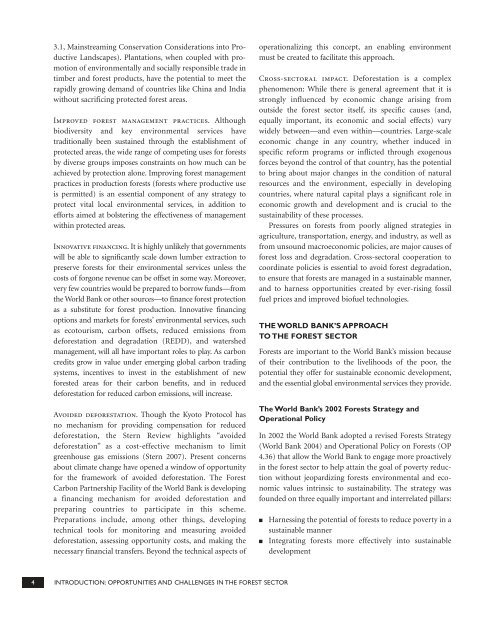Forests Sourcebook - HCV Resource Network
Forests Sourcebook - HCV Resource Network
Forests Sourcebook - HCV Resource Network
Create successful ePaper yourself
Turn your PDF publications into a flip-book with our unique Google optimized e-Paper software.
3.1, Mainstreaming Conservation Considerations into Productive<br />
Landscapes). Plantations, when coupled with promotion<br />
of environmentally and socially responsible trade in<br />
timber and forest products, have the potential to meet the<br />
rapidly growing demand of countries like China and India<br />
without sacrificing protected forest areas.<br />
Improved forest management practices. Although<br />
biodiversity and key environmental services have<br />
traditionally been sustained through the establishment of<br />
protected areas, the wide range of competing uses for forests<br />
by diverse groups imposes constraints on how much can be<br />
achieved by protection alone. Improving forest management<br />
practices in production forests (forests where productive use<br />
is permitted) is an essential component of any strategy to<br />
protect vital local environmental services, in addition to<br />
efforts aimed at bolstering the effectiveness of management<br />
within protected areas.<br />
Innovative financing. It is highly unlikely that governments<br />
will be able to significantly scale down lumber extraction to<br />
preserve forests for their environmental services unless the<br />
costs of forgone revenue can be offset in some way. Moreover,<br />
very few countries would be prepared to borrow funds—from<br />
the World Bank or other sources—to finance forest protection<br />
as a substitute for forest production. Innovative financing<br />
options and markets for forests’ environmental services, such<br />
as ecotourism, carbon offsets, reduced emissions from<br />
deforestation and degradation (REDD), and watershed<br />
management, will all have important roles to play. As carbon<br />
credits grow in value under emerging global carbon trading<br />
systems, incentives to invest in the establishment of new<br />
forested areas for their carbon benefits, and in reduced<br />
deforestation for reduced carbon emissions, will increase.<br />
Avoided deforestation. Though the Kyoto Protocol has<br />
no mechanism for providing compensation for reduced<br />
deforestation, the Stern Review highlights “avoided<br />
deforestation” as a cost-effective mechanism to limit<br />
greenhouse gas emissions (Stern 2007). Present concerns<br />
about climate change have opened a window of opportunity<br />
for the framework of avoided deforestation. The Forest<br />
Carbon Partnership Facility of the World Bank is developing<br />
a financing mechanism for avoided deforestation and<br />
preparing countries to participate in this scheme.<br />
Preparations include, among other things, developing<br />
technical tools for monitoring and measuring avoided<br />
deforestation, assessing opportunity costs, and making the<br />
necessary financial transfers. Beyond the technical aspects of<br />
operationalizing this concept, an enabling environment<br />
must be created to facilitate this approach.<br />
Cross-sectoral impact. Deforestation is a complex<br />
phenomenon: While there is general agreement that it is<br />
strongly influenced by economic change arising from<br />
outside the forest sector itself, its specific causes (and,<br />
equally important, its economic and social effects) vary<br />
widely between—and even within—countries. Large-scale<br />
economic change in any country, whether induced in<br />
specific reform programs or inflicted through exogenous<br />
forces beyond the control of that country, has the potential<br />
to bring about major changes in the condition of natural<br />
resources and the environment, especially in developing<br />
countries, where natural capital plays a significant role in<br />
economic growth and development and is crucial to the<br />
sustainability of these processes.<br />
Pressures on forests from poorly aligned strategies in<br />
agriculture, transportation, energy, and industry, as well as<br />
from unsound macroeconomic policies, are major causes of<br />
forest loss and degradation. Cross-sectoral cooperation to<br />
coordinate policies is essential to avoid forest degradation,<br />
to ensure that forests are managed in a sustainable manner,<br />
and to harness opportunities created by ever-rising fossil<br />
fuel prices and improved biofuel technologies.<br />
THE WORLD BANK’S APPROACH<br />
TO THE FOREST SECTOR<br />
<strong>Forests</strong> are important to the World Bank’s mission because<br />
of their contribution to the livelihoods of the poor, the<br />
potential they offer for sustainable economic development,<br />
and the essential global environmental services they provide.<br />
The World Bank’s 2002 <strong>Forests</strong> Strategy and<br />
Operational Policy<br />
In 2002 the World Bank adopted a revised <strong>Forests</strong> Strategy<br />
(World Bank 2004) and Operational Policy on <strong>Forests</strong> (OP<br />
4.36) that allow the World Bank to engage more proactively<br />
in the forest sector to help attain the goal of poverty reduction<br />
without jeopardizing forests environmental and economic<br />
values intrinsic to sustainability. The strategy was<br />
founded on three equally important and interrelated pillars:<br />
■<br />
■<br />
Harnessing the potential of forests to reduce poverty in a<br />
sustainable manner<br />
Integrating forests more effectively into sustainable<br />
development<br />
4 INTRODUCTION: OPPORTUNITIES AND CHALLENGES IN THE FOREST SECTOR

















